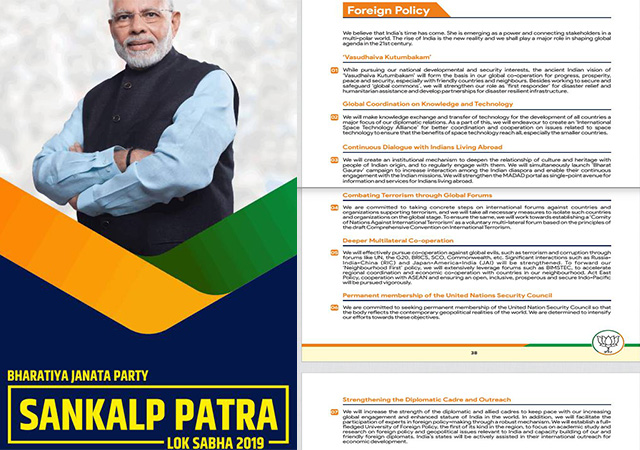
[These excerpts are from an article in the latest edition of The Round Table: The Commonwealth Journal of International Affairs.]
Abstract
Narendra Modi’s prime focus on foreign policy has made a few commentators around the world argue that India is witnessing a change in its foreign policy, and there has emerged a ‘Modi Doctrine’ based on ‘Neighbourhood-First Policy’. However, an in-depth study on the theme suggests that there are no major doctrinal changes in Indian foreign policy.
Issuing Threats, Some Actions and Then Back to Normal
As with all the earlier Prime Ministers, India’s relationship with Pakistan has remained an Achilles’ heel for Modi also, but unlike Modi, all the others had tried to find a means for long-term engagement with Pakistan. To be fair, Modi started with a goodwill message; however, soon afterwards he lost the plot. As tensions at the Indo-Pakistan border escalated, Modi went back to the election manifesto of the BJP which says ‘in our neighbourhood we will pursue friendly relations. However, where required we will not hesitate from taking strong stand and steps [sic]’ (BJP Election Manifesto 2014). This was clearly stated on India’s Independence Day on 15 August 2016 when Modi talked about providing assistance to secessionist leaders from Balochistan. Later, after more incidents at the border and militant attacks in the Kashmir valley, Modi even threatened Pakistan with scrapping the IWT of 1960 which has remained intact despite the India–Pakistan wars (1965, 1971 and 1999) and a series of military-cum-political bitterness between them. However, soon after, the government of India toned down its rhetoric and accepted an invitation from Pakistan to participate in the meeting of the Permanent Indus Commissioners at Islamabad in March 2017. Also, in the wake of the terror attack on the Uri brigade headquarters in Jammu and Kashmir on 18 September 2016, which resulted in the death of 20 Indian Army soldiers, the Government of India decided to boycott the nineteenth summit of the SAARC which was to be held in Islamabad on November 9 and 10, 2016. This decision of India was supported by the Governments of Afghanistan, Bangladesh, Nepal, Sri Lanka and Bhutan; however, they had their own justifications for not attending the summit. At the border, after the attack, the Indian Army carried out a ‘surgical strike’ on some of the militant camps operating in the Pakistan Side of Kashmir.
This sort of political behaviour is akin to Modi’s predecessors’. For example, after the attack carried out on the Indian Parliament in 2001, the Indian Army was fully alerted on the Indian border. It seemed that war between the two countries could start at any time. The situation normalised after some months, mainly, because of interference from external actors. Surgical strikes in the past were carried out, but they have never been publicised. Most commentators did not adhere to the BJP’s view in television shows. Issuing a threat for action and then getting back to normal with Pakistan has been a trick used by all past Prime Ministers of India. At organisational level, India is regarded as a reluctant member of SAARC. Due to its economic interests, India is much more active in other regional organisations such as Association of South East Asian Nations (ASEAN), than SAARC.
Conclusions
As maintained by the author, India’s South Asia policy can be broadly categorised into three doctrines. These doctrines were attuned to the then global situation and world order. During Nehru’s time, the postcolonial countries’ solidarity led India to play a major role at a global level. In the 1970s and 1980s, the Cold War superpowers became more assertive and almost all countries, despite being committed to non-alignment, took sides. Most of the NAM members tilted towards the Soviet Union because of that superpower’s socialist ideology. Having a close political relationship with the Soviet Union fulfilled the foreign policy-related objectives of India at that time. In the 1990s, as the Cold War ended, India made adjustments in its foreign policy. Post Cold War, India has taken steps such as providing economic assistance etc to the neighbouring countries to balance the presence of external actors in the South Asia.
The Gujral Doctrine assured neighbouring countries that India was ready to make adjustments and compromises to address their concerns. Almost all Indian Prime Ministers since Gujral have to a large extent have followed this doctrine. This is mainly to check the effects of the growing activities of extra-regional powers like China in South Asia.
Whatever Modi is doing is in tune with the actions of past Prime Ministers. The tactics may be unconventional and pragmatic, but the policies remain the same. This is primarily because, more than individuals, it is institutions which play significant roles in foreign policy. Those who claim that India is witnessing dynamism and changes in foreign policy under Modi also accept the role of institutions and the challenges they pose. Therefore, foreign policy remains in continuity with the past rather than undergoing significant change.
Amit Ranjan is with the Institute of South Asian Studies, National University of Singapore.
Related articles:
Key appointments of the Modi 2.0 cabinet: What they say about Modi’s second term
India braces for radical change under second term of Modi



